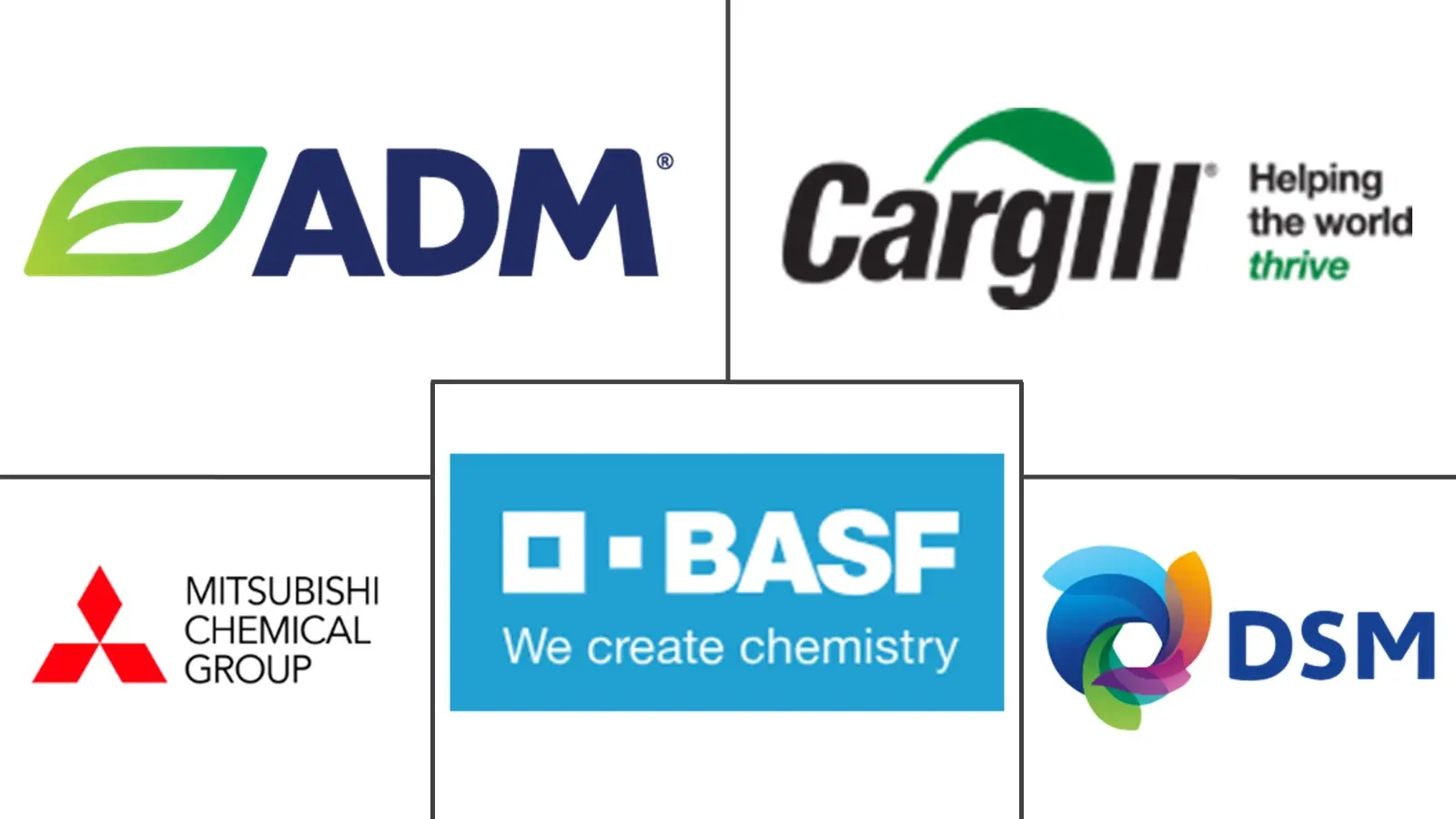Bio-Organic Acid Market Size and Share
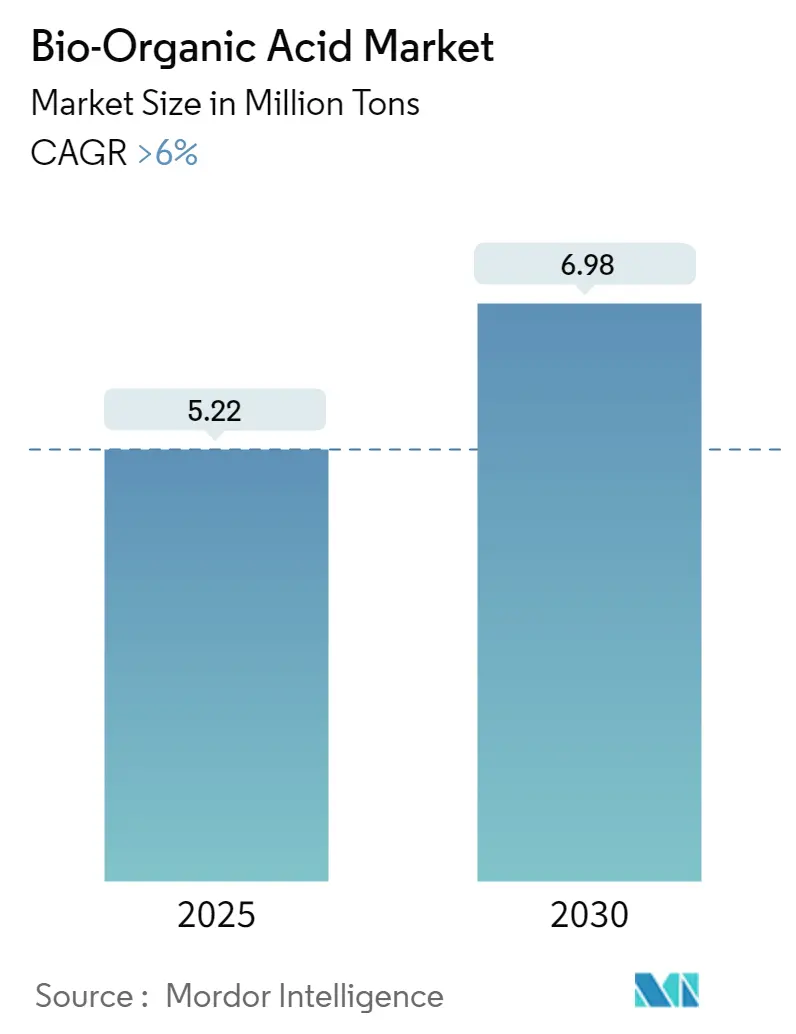
Bio-Organic Acid Market Analysis by Mordor Intelligence
The Bio-Organic Acid Market size is estimated at 5.22 million tons in 2025, and is expected to reach 6.98 million tons by 2030, at a CAGR of greater than 6% during the forecast period (2025-2030).
The COVID-19 pandemic negatively impacted the market due to nationwide lockdowns, strict social distancing measures, and disruption in supply chains. These factors negatively affected the food and beverage, textile, and coating markets, thereby affecting the market for bio-organic acids. However, the market recovered well after the restrictions were lifted. The market recovered significantly, owing to the rise in consumption of bio-organic acids in food and beverage, textile, and coating end-user industries.
The stringent regulations over conventional organic acids and the growing demand for bio-based polymers in healthcare applications are expected to drive the market for bio-organic acids.
The higher production cost of bio-based chemicals is expected to hinder the growth of the market.
The shifting focus towards eco-friendly products is expected to create opportunities for the market during the forecast period.
The Asia-Pacific region is expected to dominate the market. It is also expected to register the highest CAGR during the forecast period due to rising demand for bio-organic acids in pharmaceuticals, textiles, coatings, and food products applications.
Global Bio-Organic Acid Market Trends and Insights
Food and Beverage Industry to Dominate The Market
- The food and Beverage end-user industry is expected to dominate the market for bio-organic acid during the forecast period. Bio-organic acids and their derivatives are frequently used in beverage, food, and feed production. Acidic additives may act as buffers to regulate acidity, antioxidants, preservatives, flavor enhancers, and sequestrants.
- North America and Europe are the largest markets for food and beverages across the globe. According to the U.S. Census Bureau, monthly retail sales from U.S. retail and food services were valued at around USD 705.7 billion in November 2023, as compared to USD 704.9 billion in September. Thus, the increasing market for food and beverage products will drive the market for bio-organic acids in the country.
- Furthermore, according to the USDA, Mexico is the third-largest food processing industry in the Americas, after the United States and Brazil. According to data from the Agricultural Markets Advisory Group (GCMA), the country’s food production is anticipated to reach 290 million tons in 2023, growing from 287 million tons in 2022.
- The food and beverage sector is one of the largest manufacturing industries in Europe. According to FoodDrinkEurope, the food and beverage industry turnover increased by 2.3% in Q4 2022, compared to the previous quarter, and increased by 19.2% Y-o-Y compared to Q4 2021. Thus, the growth in food and beverage market turnover is expected to drive the market for bio-organic acid in the region.
- Germany is the largest market for food and beverage products in Europe. The food industry represents the fourth-largest industrial sector in the country. According to data from the Federation of German Food and Drink Industries (BVE), in 2022, the total revenue of food and beverage processing in the country reached USD 20.7 billion, at a growth rate of 17.9% as compared to the previous year. Thus, the growth in the food and beverage sector is expected to drive the market for bio-organic acids in the region.
- Thus, the food and beverage end-user industry is expected to dominate the market for bio-organic acid during the forecast period.
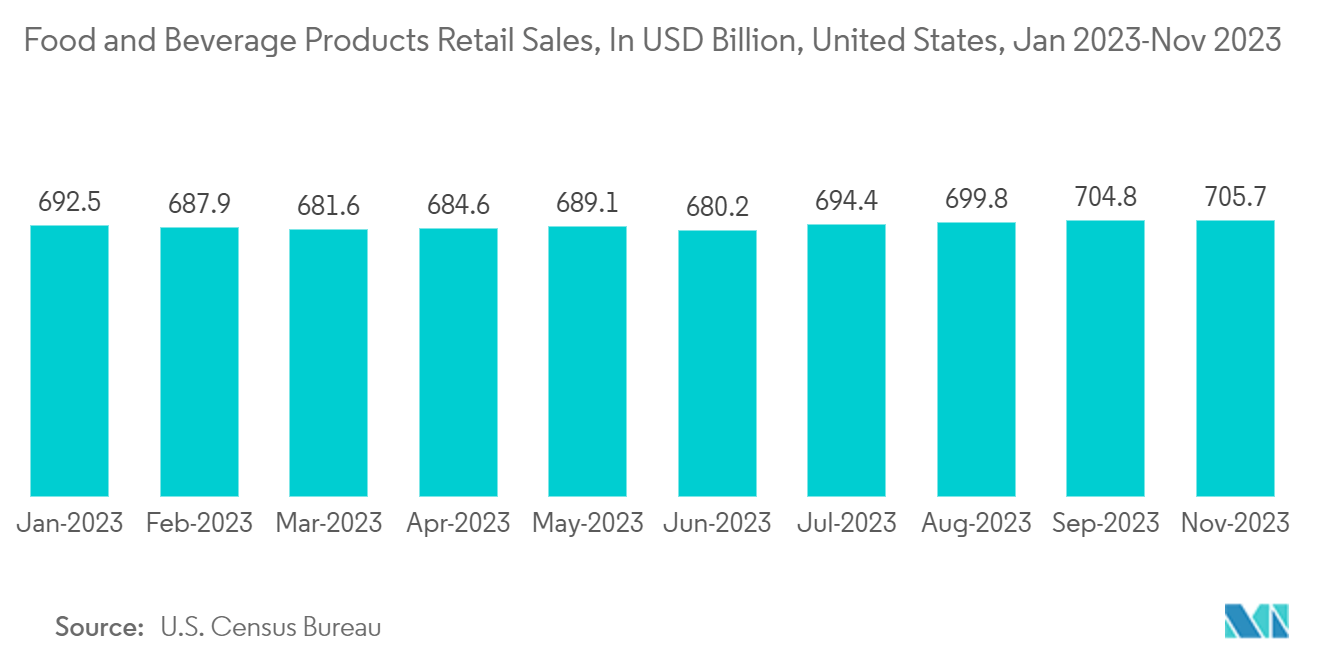
Asia-Pacific Region to Dominate the Market Growth
- The Asia-Pacific region is expected to dominate the market for bio-organic acid due to rising demand from pharmaceuticals, textiles, coatings, food and beverage end-user industries in the region.
- China and India are the largest food and beverage markets in the region. According to the China National Light Industry Council, major food manufacturing companies with an annual turnover of over USD 2.8 million reported revenues of over USD 1.53 trillion in 2022. Compared to 2021, the total revenue registered a year-on-year growth of 5.6%, indicating strong growth in the food industry.
- Similarly, in India, the food and beverage sector is expected to register a significant growth rate. According to IBEF, Indian food processing market size reached USD 307.2 trillion in 2022 and is expected to reach USD 547.3 trillion by 2028. Thus, the growth in food processing markets will increase the usage of bio-based organic acids in the country.
- The demand for bio-organic acids is increasing in the pharmaceutical sector. India is a global pharmaceutical hub, exporting pharmaceuticals to over 200 countries. In the first half of 2022-2023, foreign direct investment inflows into the pharmaceutical industry increased by 25%. According to IBEF, the pharmaceutical industry revenue is expected to reach USD 65 billion by 2024. Thus, the increasing market for pharmaceuticals will drive the current studied market.
- Furthermore, in China, the textile industry registered significant market growth. According to the National Bureau of Statistics of China, China's textile production volume accounted for 38.2 billion meters in 2022, compared to 23.5 billion meters during the same period in the previous year. In December, approximately 3.47 billion meters of clothing fabric were produced in China. Monthly textile production volume was consistently above three billion meters.
- Owing to the above-mentioned factors, the market for bio-organic acid in the Asia-Pacific region is projected to grow significantly during the forecast period.
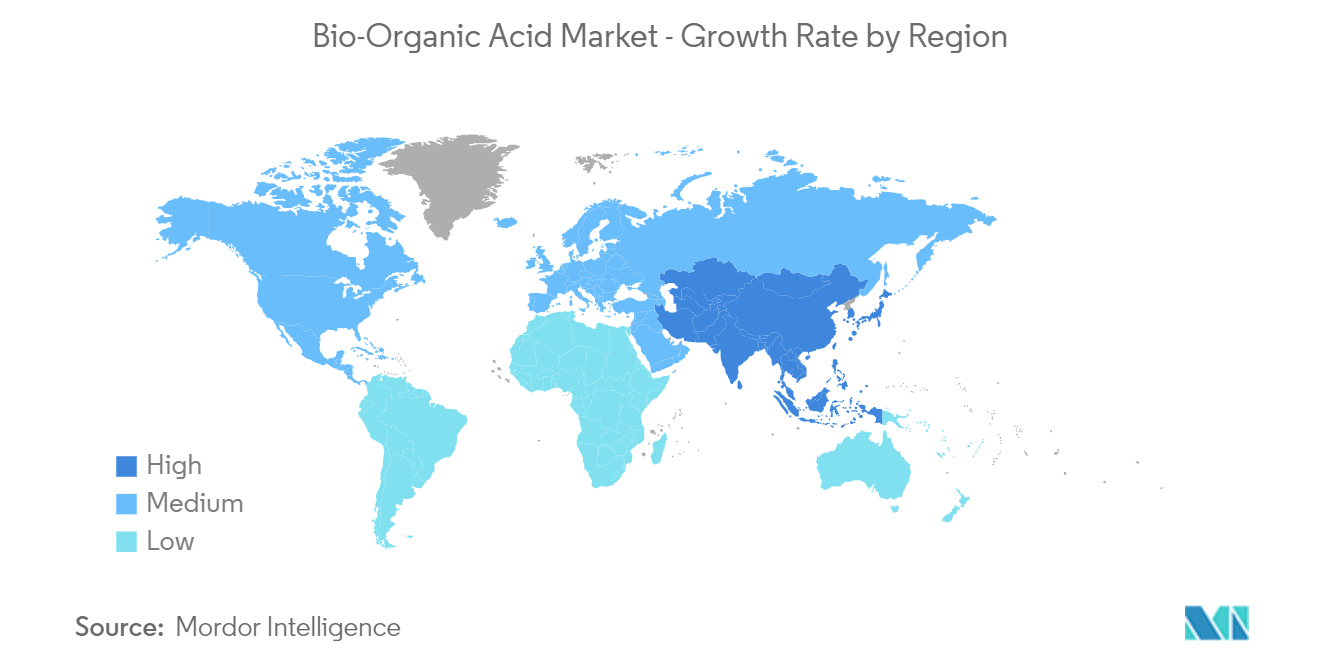
Competitive Landscape
The bio-organic acid market is fragmented in nature. Some of the major players in the market (not in any particular order) include BASF SE, DSM, Mitsubishi Chemical Corporation, Cargill, Incorporated, and ADM, amongst others.
Bio-Organic Acid Industry Leaders
BASF SE
DSM
Mitsubishi Chemical Corporation
Cargill, Incorporated
ADM
- *Disclaimer: Major Players sorted in no particular order
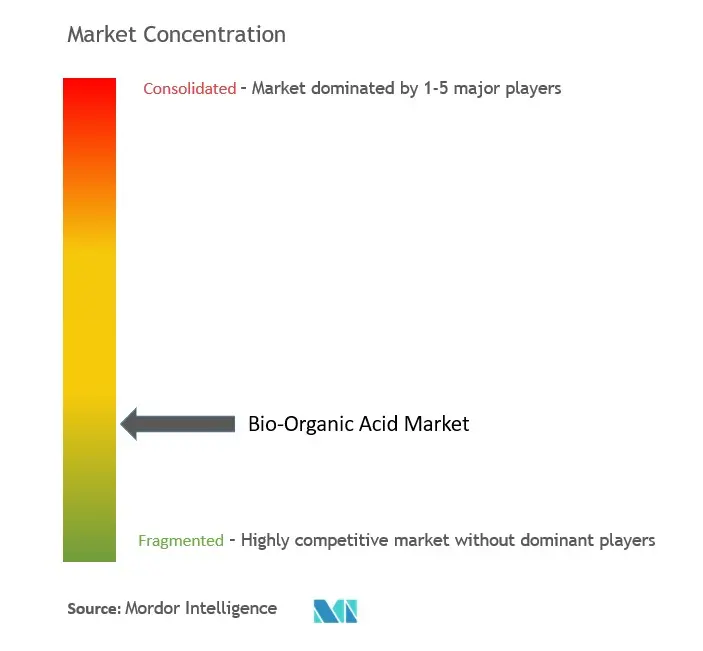
Recent Industry Developments
- October 2022: Corbion announced the production of bio-based lactic acid to fulfill the rising demand for environmentally friendly solutions in the Asia-Pacific region. The company announced its plans to build a new lactic acid facility in Thailand. The company's dedication to supplying bio-based organic acids to a larger market is demonstrated by its expansion.
- May 2022: BASF announced the extension of its line of bio-based organic acids. The company manufactured a novel biodegradable and compostable polymer based on bio-based succinic acid. The polymer is more environmentally friendly and has uses in textiles, agriculture, and packaging industries.
Global Bio-Organic Acid Market Report Scope
Bio-based alternatives to organic acid are environmentally sustainable and economical compared to synthetic products. The bio-based organic acids are used in various applications such as pharmaceuticals, polymers, lubricating oil, food, cosmetics, solvents, oxygenated diesel fuel, coatings, and other products.
The bio-organic acid market is segmented by raw material, product type, application, and geography (Asia-Pacific, North America, Europe, South America, and the Middle East and Africa). By raw material, the market is segmented into biomass, corn, maize, sugar, and other raw materials. By product type, the market is segmented into bio lactic acid, bio acetic acid, bio adipic acid, bio acrylic acid, bio succinic acid, and other product types (bio citric acid, bio fumaric acid, etc.). By application, the market is segmented into polymers, pharmaceuticals, textiles, coatings, food and beverages, and other applications (personal care, chemicals, etc.). The report also covers the market sizes and forecasts for the bio-organic acid market in 15 countries across the significant region.
For each segment, the market sizing and forecasts have been done based on volume (tons).
| Biomass |
| Corn |
| Maize |
| Sugar |
| Other Raw Materials |
| Bio Lactic Acid |
| Bio Acetic Acid |
| Bio Adipic Acid |
| Bio Acrylic Acid |
| Bio Succinic Acid |
| Other Product Types (Bio Citric Acid, Bio Fumaric Acid, etc.) |
| Polymers |
| Pharmaceuticals |
| Textile |
| Coatings |
| Food and Beverage |
| Other Applications (Personal Care, Chemicals, etc.) |
| Asia-Pacific | China |
| India | |
| Japan | |
| South Korea | |
| Rest of Asia-Pacific | |
| North America | United States |
| Canada | |
| Mexico | |
| Europe | Germany |
| United Kingdom | |
| Italy | |
| France | |
| Rest of Europe | |
| South America | Brazil |
| Argentina | |
| Rest of South America | |
| Middle East and Africa | Saudi Arabia |
| South Africa | |
| Rest of Middle East and Africa |
| Raw Material | Biomass | |
| Corn | ||
| Maize | ||
| Sugar | ||
| Other Raw Materials | ||
| Product Type | Bio Lactic Acid | |
| Bio Acetic Acid | ||
| Bio Adipic Acid | ||
| Bio Acrylic Acid | ||
| Bio Succinic Acid | ||
| Other Product Types (Bio Citric Acid, Bio Fumaric Acid, etc.) | ||
| Application | Polymers | |
| Pharmaceuticals | ||
| Textile | ||
| Coatings | ||
| Food and Beverage | ||
| Other Applications (Personal Care, Chemicals, etc.) | ||
| Geography | Asia-Pacific | China |
| India | ||
| Japan | ||
| South Korea | ||
| Rest of Asia-Pacific | ||
| North America | United States | |
| Canada | ||
| Mexico | ||
| Europe | Germany | |
| United Kingdom | ||
| Italy | ||
| France | ||
| Rest of Europe | ||
| South America | Brazil | |
| Argentina | ||
| Rest of South America | ||
| Middle East and Africa | Saudi Arabia | |
| South Africa | ||
| Rest of Middle East and Africa | ||
Key Questions Answered in the Report
How big is the Bio-Organic Acid Market?
The Bio-Organic Acid Market size is expected to reach 5.22 million tons in 2025 and grow at a CAGR of greater than 6% to reach 6.98 million tons by 2030.
What is the current Bio-Organic Acid Market size?
In 2025, the Bio-Organic Acid Market size is expected to reach 5.22 million tons.
Who are the key players in Bio-Organic Acid Market?
BASF SE, DSM, Mitsubishi Chemical Corporation, Cargill, Incorporated and ADM are the major companies operating in the Bio-Organic Acid Market.
Which is the fastest growing region in Bio-Organic Acid Market?
Asia Pacific is estimated to grow at the highest CAGR over the forecast period (2025-2030).
Which region has the biggest share in Bio-Organic Acid Market?
In 2025, the Europe accounts for the largest market share in Bio-Organic Acid Market.
What years does this Bio-Organic Acid Market cover, and what was the market size in 2024?
In 2024, the Bio-Organic Acid Market size was estimated at 4.91 million tons. The report covers the Bio-Organic Acid Market historical market size for years: 2019, 2020, 2021, 2022, 2023 and 2024. The report also forecasts the Bio-Organic Acid Market size for years: 2025, 2026, 2027, 2028, 2029 and 2030.
Page last updated on:
Bio-Organic Acid Market Report
Statistics for the 2025 Bio-Organic Acid market share, size and revenue growth rate, created by Mordor Intelligence™ Industry Reports. Bio-Organic Acid analysis includes a market forecast outlook for 2025 to 2030 and historical overview. Get a sample of this industry analysis as a free report PDF download.
